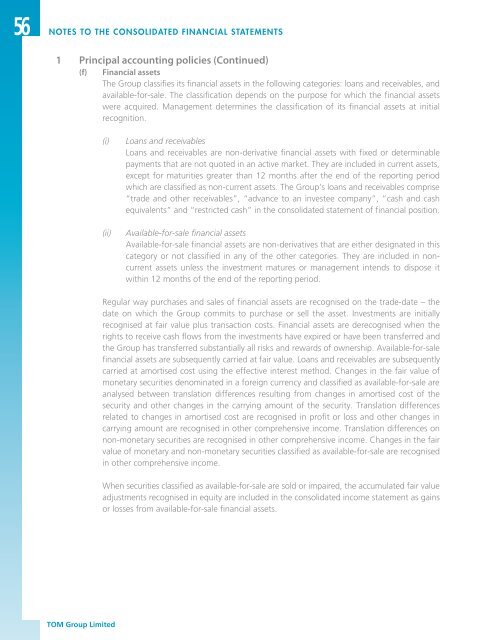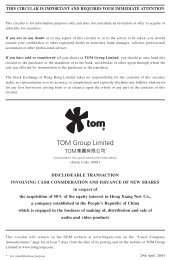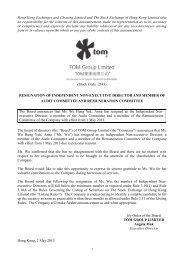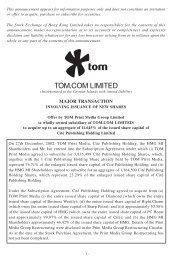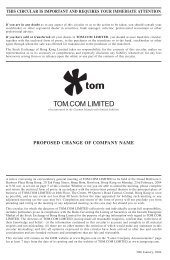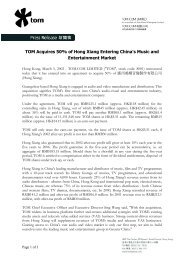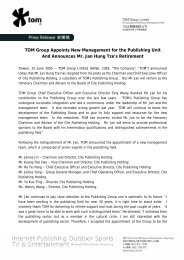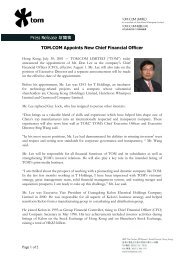2011 Annual Report - TOM Group
2011 Annual Report - TOM Group
2011 Annual Report - TOM Group
You also want an ePaper? Increase the reach of your titles
YUMPU automatically turns print PDFs into web optimized ePapers that Google loves.
56<br />
NOTES TO THE CONSOLIDATED FINANCIAL STATEMENTS<br />
1 Principal accounting policies (Continued)<br />
(f)<br />
Financial assets<br />
The <strong>Group</strong> classifies its financial assets in the following categories: loans and receivables, and<br />
available-for-sale. The classification depends on the purpose for which the financial assets<br />
were acquired. Management determines the classification of its financial assets at initial<br />
recognition.<br />
(i)<br />
(ii)<br />
Loans and receivables<br />
Loans and receivables are non-derivative financial assets with fixed or determinable<br />
payments that are not quoted in an active market. They are included in current assets,<br />
except for maturities greater than 12 months after the end of the reporting period<br />
which are classified as non-current assets. The <strong>Group</strong>’s loans and receivables comprise<br />
“trade and other receivables”, “advance to an investee company”, “cash and cash<br />
equivalents” and “restricted cash” in the consolidated statement of financial position.<br />
Available-for-sale financial assets<br />
Available-for-sale financial assets are non-derivatives that are either designated in this<br />
category or not classified in any of the other categories. They are included in noncurrent<br />
assets unless the investment matures or management intends to dispose it<br />
within 12 months of the end of the reporting period.<br />
Regular way purchases and sales of financial assets are recognised on the trade-date – the<br />
date on which the <strong>Group</strong> commits to purchase or sell the asset. Investments are initially<br />
recognised at fair value plus transaction costs. Financial assets are derecognised when the<br />
rights to receive cash flows from the investments have expired or have been transferred and<br />
the <strong>Group</strong> has transferred substantially all risks and rewards of ownership. Available-for-sale<br />
financial assets are subsequently carried at fair value. Loans and receivables are subsequently<br />
carried at amortised cost using the effective interest method. Changes in the fair value of<br />
monetary securities denominated in a foreign currency and classified as available-for-sale are<br />
analysed between translation differences resulting from changes in amortised cost of the<br />
security and other changes in the carrying amount of the security. Translation differences<br />
related to changes in amortised cost are recognised in profit or loss and other changes in<br />
carrying amount are recognised in other comprehensive income. Translation differences on<br />
non-monetary securities are recognised in other comprehensive income. Changes in the fair<br />
value of monetary and non-monetary securities classified as available-for-sale are recognised<br />
in other comprehensive income.<br />
When securities classified as available-for-sale are sold or impaired, the accumulated fair value<br />
adjustments recognised in equity are included in the consolidated income statement as gains<br />
or losses from available-for-sale financial assets.<br />
<strong>TOM</strong> <strong>Group</strong> Limited


